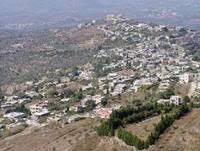Habnamra village is 65 km away from Homs. It is situated in the area known as Wadi al-Nasara. It is surrounded by a variety of thick forests full of oaks, arbutus and terebinth.
Historical accounts confirm that the village was once the scene of migratory tigers, and this is why it was called tiger pit or tiger den. It is said that it was a place where tigers fought within a wide square that extends from the current, Mary Spring to the Saint Marina shrine, so it was called “Harb Namra”, (the war of tigers), according to what was stated in a book by Dr. Elias Tannous Obeid . Thus, with the passage of time, it turned into Habnamra.
Habnamra, which is one of the most beautiful villages of “Wadi al-Nasara”, is famous for its many springs and its fresh water, as its residents depend on these springs for drinking as well as watering their crops and orchards.
The many ancient caves, which accurately depicts the ancient heritage inhabited in the region, are also among the most important characteristic of this village Some of these caves are formed by natural factors, such as: Ain Al-Qarir Cave, Al-Qandil Cave, Diwan Cave, Al-Khawashiq Cave and Ain Al-Baqara Cave, and they are popular destination for locals and visitors from neighboring villages due to their cool air and fresh water .
Many springs of Habnamra are still so far, the most famous of which are: Ain Mariam, Ain Qubei, Ain Al-Qarir, Ain Al-Sahn, Ain Al-Baeda, Ain Al-Aqra, Spring of Semaan, Ain Saleh and Ain El Hadid .
 Historical Background
Historical Background
The history of “Habnamra” dates back to the time of the Seleucids. It was inhabited in the time of the Phoenicians, Syriacs, Assyrians, and Romans. It was said that some monks sought refuge in the village’s forests during the period of sectarian conflicts in Byzantium and built the Monastery of Saint George on its hills. The monastery was attacked several times during the fourth century AD. Thus the monks had to leave it and they built another monastery in Ain Maryam on the ruins of an old church near the village of Al-Mashtaya, which overlooks Al-Hosn castle.
“Habnamra” is also famous for its many churches, cemeteries, and places of worship with huge basaltic stone doors decorated with inscriptions, crosses.There are also clay tubes to draw water , in addition to the many historical churches that still exist today, the most famous of which is the Church of St. George, which was erected in the place of an ancient church that dates back to more a hundred years ago.
In the past, the whole region depended on the silk industry, as the inhabitants of Habnamra used to grow berries to breed silkworm . There was a silk factory running on steam power in the village, and its chimney is still standing today. This region which extended between Homs and Tripoli, was called the Silk Valley.
Currently, Habnamra is famous for growing olives, vine, figs, and grains.
 It is worth mentioning that the town is one of the most promising tourist destinations, as it is located midway between Al Hosn Castle and Safita Tower.
It is worth mentioning that the town is one of the most promising tourist destinations, as it is located midway between Al Hosn Castle and Safita Tower.
Amal Farhat

